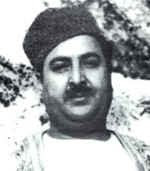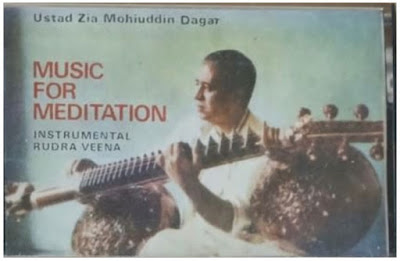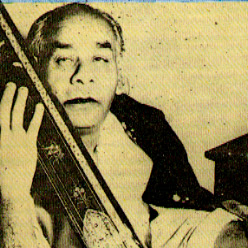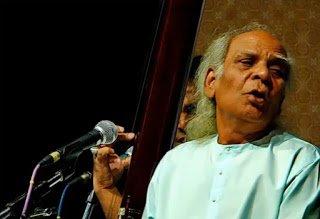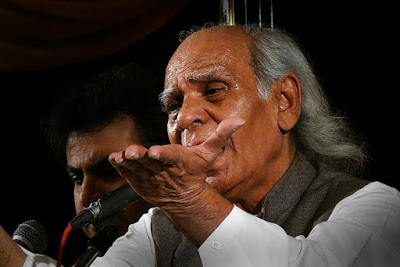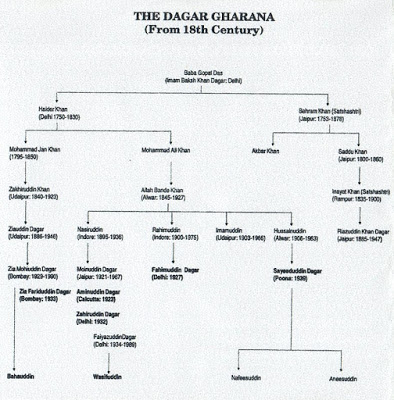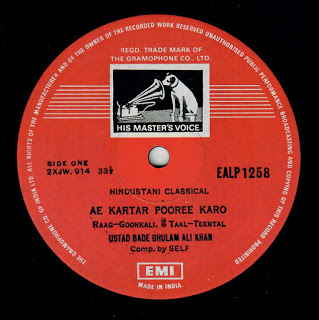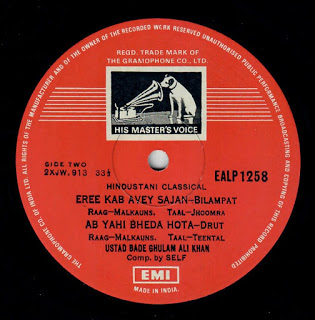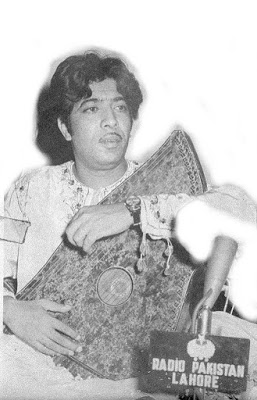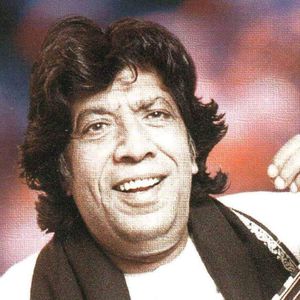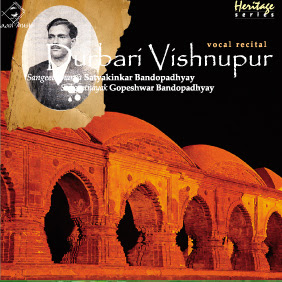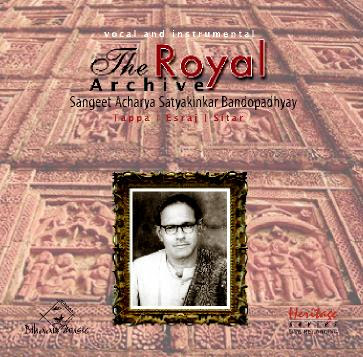We start now to post a couple of releases by the greatest female voice of India ever: Kesarbai Kerkar. She was a student of Ustad Alladiya Khan of Jaipur-Atrauli Gharana. We start with some rare archival recordings, published in the Heriatge series. This is the 4th and last volume from this series we have. For the other volumes see our recent posts.
See on her:
and especially the two book extracts at the end of this post.
From: Great Masters of Hindustani Music by Susheela Misra
Kesarbai Kerkar by Susheela Mishra
Although the legendary Kesarbai died on l6th September 1977, she had, of her own choice, faded out of public memory long before the final curtain was rung down on her long life of 87 years. Being a very fastidious and highly sensitive artiste she had voluntarily retired from the concert-stage the day she found her voice deteriorating due to old age. Consequently, when the grand old lady of Hindustani music died in 1977 there were only a few ripples of grief and a few tributes whereas in the case of other great contemporary musicians who died in the same decade, there was a flood of tributes and articles. Long ago, connoisseurs of music had placed her on a high pedestal, and there she stayed till the end, for, she had chosen to keep herself “contemptuously aloof from the rat race.” All her life she strove for perfection in her art, and such was her devotion to the musical traditions of her Gharana (the Jaipur-Atrauli or Alladiya Khan gharana) that she never cared to lower her lofty standards, not even to attract a large audience. Whereas the art of most of the great musicians of our times has been caught and preserved for us and for posterity through the highly-sophisticated L.P. Discs and tapes in AIR s priceless Archives, it looks as if Kesarbai was determined not to leave any trace of her grand music for posterity. Perhaps this apathy stemmed from her disillusionment at the deterioration in musical standards! She literally kept her brilliant musical flame hidden under a bushel so that for the majority of her contemporaries, Kesarbai’s music remained a rare musical curio, accessible to a few lucky fans only. Few heard of her, and fewer still had the good fortune to hear her grand music, her “rarely luminous and sonorous voice which could swoop down from a splendorous high taar-saptak to a deep resonant low mandra-saptak with incredibly uniform volume, and loud enough to be heard without a mike.”
In the prime of her life, Kesarbai had moved the hearts of poets and prime ministers through her music. To the end, she treasured the deeply touching note that Poet Rabindranath Tagore had written in 1938 after hearing her music. Acclaiming her as the “Queen of Melody” (Surashree), the poet had written :- “I consider myself fortunate in securing a chance for listening to Kesarbai’s singing which is an artistic phenomenon of exquisite perfection… The magic of her voice with the mystery of its varied modulations has repeatedly proved its true significance not in any pedantic display of technical subtleties mechanically accurate, but in the revelation of the miracle of music only possible for a born genius”.
Was it not a great pity that this divinely-gifted voice could not be heard actually by the majority of music-lovers scattered across the length and breadth of this vast sub-continent even though Kesarbai remained in excellent form for more than 20 years?
Out of the various Gharanas of Khayal-singing that are current today, one of the most difficult to appreciate and master perhaps is the Alladiya Khan Gharana. In Maharashtra, Alladiya Khan was called “Gaayan Maharshi” because more than 40 years of his life had been devoted to tapasya in the pursuit of this art, He jealously guarded his musical wealth, and apart from his brother Haidar Khan and sons Manji Khan and Bhurji Khan, very few outside his own family-circle succeeded in being accepted as his disciples. Only two “outsiders” measured up to Alladiya Khan’s exacting standards. They were Kesarbai Kerkar and Moghubai Kurdikar.
The story of how Kesarbai steadfastly stuck to her training under her Ustad despite the many difficulties she encountered, and how unwaveringly she pursued the single aim of her life, is remarkable. A real sangeeta-bhakta acquires his or her art through total dedication and “penance” (tapasya). Kesarbai devoted more than 20 years of the best part of her life to this sadhana, so that when she eventually emerged in public, the listeners were at once impressed by her remarkably trained voice, the polish and maturity of her performances, and her mastery over such a difficult style.
Born on July 10, 1890 in the small village of Keri (7 miles from Panaji) in Goa, Kesarbai’s intense love for music was evident even as a child. The devotional music in the temples was what drew her to music. In her own words:- “In those days, the only centre of music was the temple. One heard only Kirtans, Bhajans, and other devotional songs. I used to listen to these carefully, and back home I would try to hum them just as today’s boys and girls try to imitate film songs.”
Kesarbai’s maternal uncle, a lover of classical music, encouraged the little girl by taking her to the nearby Mangesh temple. But the Pujaris there could teach her only Bhajans and Kirtans. At the age of 8 her real music lessons began under Ustad Abdul Karim Khan in Kolhapur, but these had to be discontinued when she had to return to Goa a year later. The next 19 years or so were a period of frustrations and disappointments, because bad luck seemed to pursue her in all her attempts to learn music. She had to go from place to place to learn music ; but each time she started her lessons under a good and sincere guru, the latter would shortly be called away to a distant place by some rich patron.
In 1908, Kesarbai along with her mother and uncle, migrated to Bombay and for the next 6 years, she was able to take lessons from Barkatullah, a reputed Sitariya of the Mysore and Patna Darbars. For a year or so after discontinuing Barkatullah’s lessons, Pandit Bhaskarbua Bhakle (a disciple of Nathan Khan and Ustad Alladiya Khan) trained her, but Pandit Bhakale had to shift to Poona. Pt. Ramkrishnan Buva Waze was her next guru. Thus continued her interrupted training under different gurus until a time came when Kesarbai got quite tired of it all and resolved that she would learn only from Ustad Alladiya Khan and from no one else. But the Ustad bluntly refused. After much persuasion, however, he reluctantly agreed to teach her, but not before he had laid down a number of “conditions” about the lessons. The determined young pupil was not deterred by all these. In 1920 Kesarbai became Alladiya Khan’s serious disciple after a real Ganda-Bandh ceremony in which she had to pay him “a neat lump-sum. As for the Ustad, once he accepted her as his shagird, and realised her sincerity of purpose and love for the art, he began to devote most of his time for her taleem. He would spend 9 to 10 hours each day teaching and guiding her during her riyaz. He was an extremely fastidious, thorough, and unsparing teacher, and his first concern was her voice-culture. He would make her repeat each note- combination (palta) hundreds of times until she became “note- perfect”.
From 1920 to 1946, Kesarbai underwent all the arduous hours (“each day, more than 10 hours of riyaz”) of practice and training imposed on her by her Ustad, and in the course of a decade or two, attained the musical status desired by him. An important part of her training and one that gave her immense confidence and professional experience, was that Khan Sahib used to take Kesarbai everywhere and make her sing with him in all his concerts. The most memorable of these, according to her, was the Vikramaditya Conference in Bombay in January 1944 where she sang with her guru. The “gayanmaharshi” died in his nineties in 1946.
Kesarbai’s solo-concert career began after her Ustad’s death. Her fame spread far and wide, from Maharashtra to Delhi and Calcutta, and even to the South. Her very first recital that I heard was in a Madras Music Conference; later on, I was lucky to hear her in many a Calcutta Music Conference. Some of the important requisites for good classical music are a steady, trained voice, purity of ragas, good sahitya, clear intonation, proportionate embellishments, and feeling in presentation. Kesarbai’s chief asset was her firm, flexible, polished, well-trained voice. In a country where the supreme importance of voice-culture in music has not yet been fully realised, her voice stood out as an example of what voice-culture can be achieve ! From the lower octave (mandra saptak) to the higher (Taar saptak), her voice rang out in full-throated ease and uniform volume. The usual tendency among singers is to produce the higher notes in a squeaky falsetto voice. Kesarbai’s style faithfully reflected all the special features of the Alladiya Khan gharana – such as rendering the Khayal mostly in the Vilambit and medium tempo, systematic elaboration of words woven into carefully worked-out note-combinations set in variegated rhythmic patterns, open-voice (Akaar) production, and a preference for unusual and difficult ragas and raga-combinations.
Although Kesarbai believed in laying equal emphasis on Bhava (mood) and Artha (meaning) of the song, the real charm of her music lay not in emotional expressiveness, but in the perfect precision of her swaras, tal and bol combinations. The systematic and well arranged alaps, taans and bol-taans, all ending accurately on the mukhda (the repetitive opening-line of the song) reveal years and years of hard practice. Kesarbai’s carefully assembled clusters of note-combinations have been likened to “precious gems spread out against a velvety background”. Her variegated, forceful taans have been compared to “jets of water from a fountain”, and to “fireworks which shoot up high, and come down in a burst of colours”. She used to take special delight in rendering rare raga- combinations like Basanti-Kedar, Sawani-Nat, Nat-Bilawal, Sawani-Kalyan etc. With rare ease, she rendered varieties of a Raga such as those of Malhar, Nat, Kanada and so on with all their hairsplitting differences. Perhaps it was to this all-round excellence that Pandit Buwa Waze referred to when he compared her music to “a bouquet of fragrant flowers sprinkled with costly itter (scent)”.
The style and standard that Kesarbai had mastered after long decades of “passionate pursuit of perfection” were admired by everyone and hard to equal. She refused to make any compromises with her music, and in the process, lost rapport with the contemporary world of music-lovers. She remained allergic to broadcasting and aloof from AIR, the only medium that can take the greatest music to the masses. Except for her rare soirees and concert-appearances in Bombay and Calcutta, there was no chance to hear her. Apart from the fact that Kesarbai preferred to maintain the exclusiveness of her music, it was a style that hardly allowed any concessions for mass- popularity. Therefore, she remained essentially a musicians’ musician. Siddheswari Devi, Begum Akhtar, and M.S. Subbalakshmi have been among her ardent admirers.
Although she was one of the most rarely heard contemporary classical musicians, she was one of the most admired artistes and her name became almost legendary as one of the most dedicated sangeet-sadhaks of this century. Her music and her personality were alike dignified. It seems a great pity that posterity will have to judge this “musical aristocrat” merely on the basis of her few gramophone records, into the limited radius of which it is difficult to compress an elaborate style like hers. Throughout her career as a musician, Kesarbai maintained her dignity, prestige and high standards. As she said once :-“I have brought a certain amount of prestige and dignity to music as a career”. Smt Indira Gandhi, the Prime Minister, once remarked about Kesarbai: “Through the purity of her music and the dignity of her performance, she has moulded our standards of appreciation and has profoundly impressed other musicians.” Many laurels and awards came her way. Tagore hailed her as “Surashri.” She was the first woman to have received the Presidential Award in Hindustani Music (1953), and the first Rajya Gaayika of Maharastra (1969), and finally she was honoured with the Padma Bhushan in 1971. However, she rarely used these with her name. Her admirers in Bombay who were able to attend some of her exclusive soirees even in her old age, say that “there was no diminution in her august virtuosity, phenomenal breath-control and wide range of 3 octaves” all of which left her listeners breathless with wonder. The impact of her music continued to be intellectual and aesthetic at the same time. One wishes that at least Long- playing Commercial Discs would be soon m ade out of the rich treasures of her privately taped music.
As soon as Kesarbai began to feel that she could no longer give of her best in music, she sadly withdrew herself from the musical scene and became a recluse in her elegant home. In one of her last interviews when she had become an aged and ailing figure in her 82nd year, Kesarbai had told the interviewing music-critic : “I am ready for the final journey. But I have no regrets. I have the satisfaction of a good job well done. For 70 years I have sung for the gods, and if, incidentally, I have also delighted the Indian people, I am doubly happy”.
From: Down Melody Lane (1984) by G.N. Joshi
Kesarbai Kerkar
Goa is world famous for its scenic beauty as well as its mineral wealth. Besides this, it has given to the world extraordinarily gifted musicians, sculptors, painters, poets, writers and singers. From the beginning of this century the Goan wealth of artistry has flowed in a stream towards Bombay. Wealthy Gujaratis and Parsis vied with each other to welcome and patronize these artists. As a result Bombay has become a haven for many of the artists migrating from Goa.
Kesarbai Kerkar, from the village of Keri in Goa, was one of those who settled in Bombay. Gurudev Ravindranath Tagore honoured her with the title ‘Surashri’. The Indian government awarded her the Padmabhushan, and Maharashtra adorned her the title Maharashtra Rajya Gayika.
This brilliant singer died a few years ago at a ripe old age. It is indeed difficult to do full justice to her illustrious career in a brief account. She was the disciple of such eminent gurus as Ramkrishnabuva Vaze, Bhaskarbuva Bakhale and Ustad Alladiya Khan. She studied music under these masters for no less than 25 years, and became a proficient exponent of the gayaki of the Jaipur gharana. Her voice had a range of three saptakas, and she could move through the whole range with ease. Her presentations of khayals were models of graceful elaboration. She used to present all the facets of each raga in her deep, full throated voice. Her alap was always serene and dignified and it gave a fascinating outline of the raga which would follow in the bandish. The bandish was firmly rhythm- bound and one could also easily discern the salient features of the raga through it. The beauty of the long interwoven themes, taans and palatas held the audience spellbound. She became known through the length and breadth of India for her unique style of presentation. Kesarbai had a very dignified and regal personality. Perhaps that is why she was patronised by the royal houses of Kashmir, Baroda, Kolhapur, Jaipur and Jodhpur. She was fully aware of her talents and abilities and she always performed with self-confidence. This was why she was sometimes misunderstood to be conceited and proud. She was always very particular to ensure that she got the honour and homage due to her and which she fully deserved as an artist par excellence.
Whenever she came to our studio for recording we always treated her with the respect that was her due. Vases with beautiful fresh flowers adorned the studio, rose water was sprinkled all over, and she was given an elevated seat. These decorative surroundings added to the charm of her most enchanting music. True to her nature, she nearly always entertained Maharajas. She never sang for the ordinary public. She thus had made it a rule to sing for people of a certain class and calibre. At a period when other artists hankered after publicity and were always willing to perform on the radio, or cut records, she never cared for the media. Money and fame came to her without any effort on her part.
When we began making LP recordings I naturally wanted her to sing for an LP, but she refused to do so. There was an interesting reason for this refusal. Around 1954-55 she had recorded some 78 r.p.m. discs. In those days we used to get sample copies for approval and out of respect for the artist we always consulted him or her. Accordingly I sent Kesarbai the sample copies for her approval. Out of the ten sides she had recorded, she desired to re-record four because, in her opinion, they were not up to her standard, In deference to her wishes we held back the issue of the four sides and requested her to re- record them. When, for over 8 months, she did not do so on grounds of ill-health, my boss became very restive and wondered that Kesarbai, a mere artist should have the audacity to disregard the wishes of the world-famous gramophone company (HMV). One day he called me to his room and virtually ordered me to carry a message to her. ‘Make it clear to her’, he said, ‘that if she does not come for re-recording within a fortnight we will publish the records as they are. We cannot afford to wait any longer’.
I tried to make him realize that this was not the right way to deal with an artist of her stature. But the boss refused to see the wisdom of my reasoning, and in a fit of temper, told me to convey his exact words to her. This boss was the one Begum Akhtar had described as ‘Kudhon ke Badhshah’. The next day I went to Kesarbai’s residence and requested her to come and re-record but she again declined to do so on grounds of ill- health. I had no other alternative now but to give her the message in so many words. I said to her, ‘I am directed by my boss to carry a message to you. Before I do so I must make one thing very clear. When I give this message I am speaking in “my Master’s voice”‘. I hated myself for doing it but as I was working with HMV I had to give her the message.
It naturally made her furious and she went red in the face. For a minute or so she was quiet; then she said to me in a hard tone, ‘Go and tell that fellow that Kesarbai will never again enter the precincts of your studio’.
And true to her word, she severed all relations with the company. Luckily she was magnanimous enough to understand my position and did not blame me. My only fault was that I had been indiscreet enough to convey the fatal message to her. My relations with her remained very cordial till the end but the company suffered the irreparable loss of an artist of rare quality. In retaliation she wrote a letter to our company withdrawing from us the right to play her gramophone records from any station of All India Radio. Accordingly, AIR had to suspend the playing of her records. Her records, however, continued to be broadcast by Goa Radio. Goa was then Portuguese territory and she, having originally come from Goa had innumerable admirers there. After independence, the people of Goa, who now came under Indian jurisdiction, were deprived of the privilege of hearing her on the radio.
I have always regretted that we could not make even one LP with her. We tried to make up for this by issuing an LP of the 78 r.p.m. recordings of her which we had issued previously. Somewhere around 1942-44 Kesarbai honoured me with a visit to my house in Dadar. I was glad to see her and was pleasantly surprised when she told me the reason for doing me this honour. She had just come back after an engagement with the prince of Kashmir. While there, she was asked by the Maharani to sing a devotional song. She therefore requested me to suggest a suitable bhaktigeet. I sang a few bhajans I knew and one of these she liked very much. The story of the bhajan was this: Radha prays to god that she may be transformed into a flute so that she might get from Lord Krishna what as Radha she would never get. The bhajan then described how the flute was played morning, evening and night, and how she was rewarded by Lord Krishna. The tune I gave this bhajan was very appropriate and was also in perfect classical style. The mukhada was in Rag Tilang and the three antaras had the tunes of fitting morning, evening and night ragas. Kesarbai got the song written out and made me sing it several times. I unfortunately did not have the good fortune to hear her sing this composition in her incomparable voice and style. Maybe it was only heard within the walls of the royal palace in Kashmir.
A year before her demise she was completely bed-ridden. Sur Singar Samsad decided to honour her at her residence. I accompanied our president Mr. V.S. Page and director Mr. Brij Narayan to her residence and we paid our homage to this ‘Gantapasvini’ (a lady singer totally dedicated to her art). She very endearingly asked me to sit near her and sing to her one of my popular songs.
Soon after this, while I was away on a visit to America, Kesarbai breathed her last, and Indian Classical Music was left poor and forlorn. While extolling Kesarbai’s artistic genius, I have one regret. She kept her exemplary talents to herself alone. In her long life of nearly 90 years she did not have a single disciple who could carry further her inimitable gayaki and tradition of the Jaipur gharana. Maybe she did not come across a disciple worthy of receiving her art and blessings.
from: https://www.parrikar.org/vpl/?page_id=328


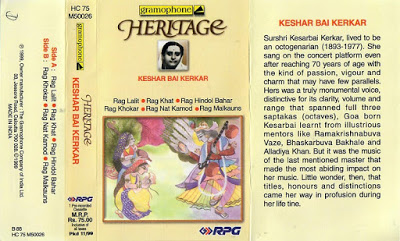

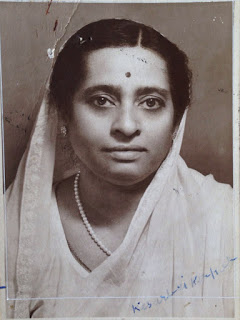
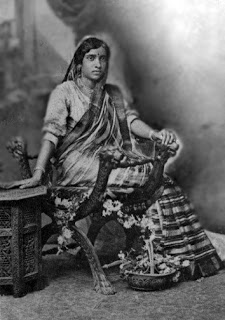
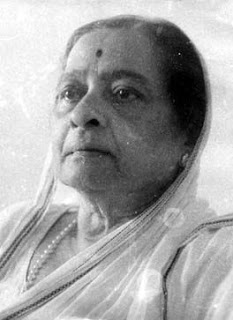
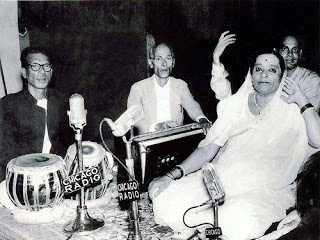
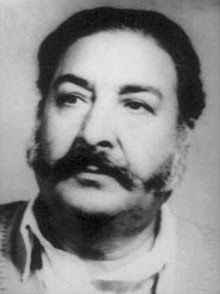
.jpg)
